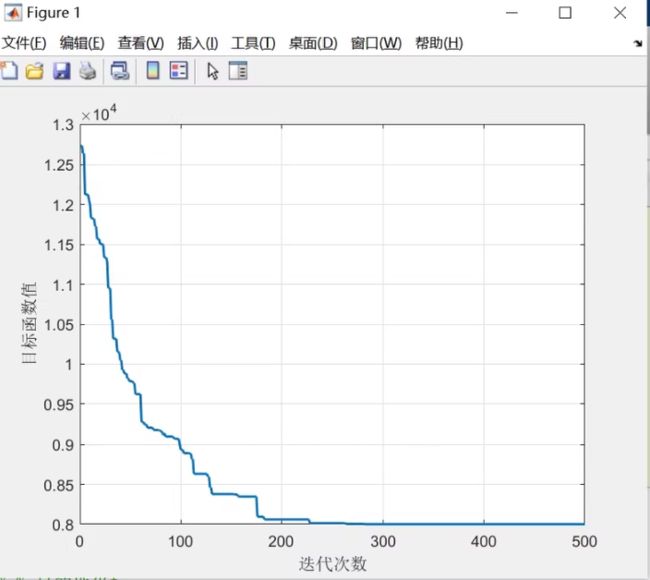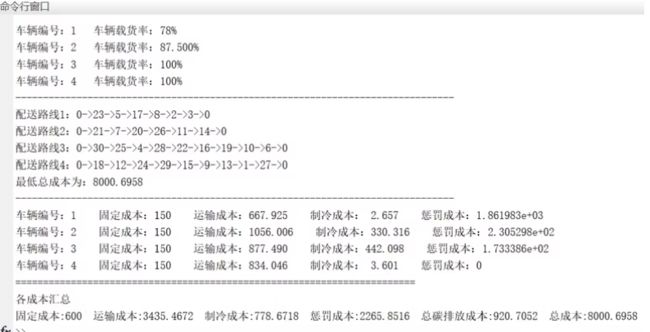- 手把手教程:在 VS2017 32位 Windows 环境下编译 OR-Tools 9.6 并集成到 C++ 项目
A小庞
C++知识算法c++开发语言or-tools算法库
OR-Tools是Google开源的优化算法库,支持路径规划、线性规划、约束编程等多种功能。本文将详细介绍在VisualStudio201732位Windows环境下编译OR-Tools9.6的两种方法:联网自动下载依赖和手动编译依赖项,并提供避坑指南。方法一:联网自动下载依赖(推荐新手)步骤1:克隆OR-Tools仓库gitclonehttps://github.com/google/or-to
- 基于MATLAB的资源优化与工期固定-资源均衡分析方法研究【附代码】
拉勾科研工作室
matlab开发语言
算法与建模领域的探索者|专注数据分析与智能模型设计✨擅长算法、建模、数据分析matlab、python、仿真✅具体问题可以私信或查看文章底部二维码✅感恩科研路上每一位志同道合的伙伴!(1)资源均衡优化相关理论与问题分类在现代工程项目中,资源的合理分配和使用是确保项目按时完成、成本可控的关键因素。资源均衡优化作为项目管理中的核心环节,旨在通过调整资源的使用方案,使资源消耗在整个工期内尽可能平稳,避免
- 医学图像增强的层级化模糊与虚拟仪器无参考质量评价研究【附代码】
拉勾科研工作室
计算机视觉图像处理人工智能
算法与建模领域的探索者|专注数据分析与智能模型设计✨擅长算法、建模、数据分析matlab、python、仿真✅具体问题可以私信或查看文章底部二维码✅感恩科研路上每一位志同道合的伙伴!(1)层级模糊隶属度的X光医学图像增强算法针对X光医学图像普遍存在的对比度差、细节模糊等问题,本算法提出了一种基于层级模糊隶属度的增强方法。该方法的核心思想在于利用拉普拉斯金字塔分解图像,并在多尺度下分层计算模糊隶属度
- 《现代通信原理与技术》模拟调制与解调—FM 调制实验报告
不想秃头的程序
人工智能matlab信息与通信信号处理
摘要本实验旨在通过MATLAB软件进行模拟调制与解调的实践,加深对频率调制(FrequencyModulation,FM)原理的理解,并掌握FM调制与解调的实现方法。关键词:MATLAB引言在现代通信系统中,调制技术是实现信息传输的核心方法之一。频率调制(FrequencyModulation,FM)作为一种重要的模拟调制方式,通过改变载波信号的频率来传递信息,广泛应用于广播、电视、无线通信等领域
- 鸿蒙仓颉开发语言实战教程:页面跳转和传参
湖北穷逼首席代表
harmonyos开发语言华为
合集-仓颉教程(25)1.详解鸿蒙仓颉开发语言中的日志打印问题05-212.鸿蒙仓颉开发语言实战教程:实现商城应用首页05-223.鸿蒙仓颉开发语言实战教程:页面跳转和传参05-254.鸿蒙仓颉语言开发教程:页面和组件的生命周期05-285.鸿蒙仓颉语言开发实战教程:购物车页面06-036.鸿蒙仓颉语言开发实战教程:商城登录页06-047.鸿蒙仓颉语言开发实战教程:商城搜索页06-058.鸿蒙仓颉
- 鸿蒙仓颉语言开发实战教程:购物车页面
王家那谁
harmonyos华为
合集-仓颉教程(25)1.详解鸿蒙仓颉开发语言中的日志打印问题05-212.鸿蒙仓颉开发语言实战教程:实现商城应用首页05-223.鸿蒙仓颉开发语言实战教程:页面跳转和传参05-254.鸿蒙仓颉语言开发教程:页面和组件的生命周期05-285.鸿蒙仓颉语言开发实战教程:购物车页面06-036.鸿蒙仓颉语言开发实战教程:商城登录页06-047.鸿蒙仓颉语言开发实战教程:商城搜索页06-058.鸿蒙仓颉
- HarmonyOS NEXT仓颉开发语言实战案例:简约音乐播放页
幽蓝计划
开发语言harmonyos
偶然间看到一个非常漂亮的音乐播放器设计图,忍不住想拿仓颉语言来练练手,当漂亮的设计图遇到优美的开发语言,简直是天作之合。看到这个页面,我们先做一个简单的分析。整个页面分为上中下三个部分,顶部为导航栏,底部是歌词工具栏,剩下的就是中间的歌曲信息和控制按钮部分。它们的部分方式是比较简单的纵向布局。页面大致结构代码如下:Column{//导航栏Stack{Text('NowPlaying').fontS
- ArkTS 开发学习路径全攻略:从入门到实战
码农乐园
学习
随着HarmonyOS的持续演进,ArkTS(ArkTypeScript)已成为鸿蒙系统的主力开发语言。特别是HarmonyOSNEXT推行纯鸿蒙化后,ArkTS成为构建鸿蒙原生应用的唯一选择。本文将为你梳理一套系统化的学习路径,从语法基础到实战项目,再到系统能力调用与分布式开发,一步步带你成为合格的鸿蒙开发者。第一阶段:ArkTS语言和HarmonyOS基础入门学习目标:掌握ArkTS基础语法;
- java毕业设计房产中介系统mybatis+源码+调试部署+系统+数据库+lw
兮兮科技
javamybatis开发语言
java毕业设计房产中介系统mybatis+源码+调试部署+系统+数据库+lwjava毕业设计房产中介系统mybatis+源码+调试部署+系统+数据库+lw本源码技术栈:项目架构:B/S架构开发语言:Java语言开发软件:ideaeclipse前端技术:Layui、HTML、CSS、JS、JQuery等技术后端技术:JAVA运行环境:Win10、JDK1.8数据库:MySQL5.7/8.0源码地址
- MATLAB实现WOA-BP鲸鱼优化算法优化BP神经网络多输入单输出回归预测(含模型描述及示例代码)
nantangyuxi
MATLAB含模型描述及示例代码算法matlab神经网络大数据人工智能深度学习机器学习
目录MATLAB实现WOA-BP鲸鱼优化算法优化BP神经网络多输入单输出回归预测(多指标,多图)1项目背景介绍...1项目目标与意义...2项目挑战...3项目特点与创新...5<
- HarmonyOs开发之——TypeScript介绍、入门,及 TypeScript、JavaScript、ArkTs的具体区别解读。
chenrui310
ubuntulinux运维
HarmonyOs开发之——TypeScript介绍、入门,及TypeScript、JavaScript、ArkTs的具体区别解读。一、开发语言介绍:TypeScript是JavaScript的超集,ArkTS则是TypeScript的超集。ArkTs是HarmonyOs的主力开发语言,它在TypeScript(简称TS)的基础上,匹配ArkUI框架,扩展了声明式UI、状态管理等相应的能力,让开发
- C#上位机开发进阶:多协议融合通信(S7、Modbus TCP、OPC UA)与西门子PLC联动
威哥说编程
网络tcp/ip网络协议c#服务器开发语言
随着工业自动化和智能制造的快速发展,不同协议的设备和系统需要高效协同工作。这不仅要求我们能够与西门子PLC等设备进行有效通信,还需要能够跨越不同协议进行数据交换和设备控制。S7协议、ModbusTCP协议以及OPCUA协议是工业自动化领域中广泛应用的协议,而C#作为强大的开发语言,提供了丰富的库和工具来实现这些协议的融合通信。本文将通过实际示例,介绍如何在C#中实现多协议融合通信(S7、Modbu
- c语言opencv所用库函数,Py之cv2:cv2库(OpenCV,opencv-python)的简介、安装、使用方法(常见函数、方法等)最强详细攻略...
weixin_39729272
c语言opencv所用库函数
##关于OpenCV简介##OpenCV是一个基于BSD许可(开源)发行的跨平台计算机视觉库,可以运行在Linux、Windows、Android和MacOS操作系统上。它轻量级而且高效——由一系列C函数和少量C++类构成,同时提供了Python、Ruby、MATLAB等语言的接口,实现了图像处理和计算机视觉方面的很多通用算法。OpenCV用C++语言编写,它的主要接口也是C++语言,但是依然保留
- PHP基础1(php基础语法,变量与常量,数据类型,运算符)
一.前言我们开始介绍一下php基础,这个只是作为一个小的知识点,让大家大概了解一下php,作为一个后端开发语言,还是很有必要了解的。PHP:HypertextPreprocessor(超文本预处理器)php的作用就是生成动态的html文档二.php基础语法echo在html中输出内容用的,php的代码写在里面三.php的常量与变量变量:可变化的值常量:不变的值圆周率:3.1415#PHP中的变量用
- 数学实验matlab课后习题,数学实验练习题(MATLAB)
沈洲行
数学实验matlab课后习题
注意:在下面的题目中m为你的学号的后3位(1-9班)或4位(10班以上).第一次练习题1.求解下列各题:1)30sinlimxmxmxx->-2)(4)cos,1000.0=xmxyey求3)21/20mxedx?(求近似值,可以先用inline定义被积函数,然后用quad命令)4)4224xdxmx+?50x=展开(最高次幂为8).2.对矩阵21102041Am-???=??-??,分别求逆矩阵
- 深入浅出ArkTS:HarmonyOS应用开发的新选择
vvilkin的学习备忘
#HarmonyOSharmonyos华为
在移动应用开发领域,选择合适的编程语言对开发效率和性能优化至关重要。随着华为HarmonyOS的崛起,ArkTS作为其官方推荐的应用开发语言,逐渐受到开发者关注。ArkTS基于TypeScript,融合了声明式UI、响应式编程等现代前端开发范式,同时针对HarmonyOS进行了深度优化。本文将全面介绍ArkTS的核心特性、语法基础、与TypeScript的异同,以及它在HarmonyOS生态中的应
- 信创时代技术栈选择与前景分析:国产替代背景下的战略路径与实践指南
猿享天开
信创开发系统安全科技创业创新开发语言
博主简介:CSDN博客专家、CSDN平台优质创作者,高级开发工程师,数学专业,10年以上C/C++,C#,Java等多种编程语言开发经验,拥有高级工程师证书;擅长C/C++、C#等开发语言,熟悉Java常用开发技术,能熟练应用常用数据库SQLserver,Oracle,mysql,postgresql等进行开发应用,熟悉DICOM医学影像及DICOM协议,业余时间自学JavaScript,Vue,
- AI 在自动驾驶路径规划中的深度强化学习优化
QuantumWalker
人工智能自动驾驶机器学习
```htmlAI在自动驾驶路径规划中的深度强化学习优化在当今快速发展的科技领域中,人工智能(AI)的应用正在不断拓展其边界。特别是在自动驾驶技术中,AI的应用已经从简单的感知和识别发展到了复杂的决策和控制阶段。其中,深度强化学习作为AI的一个重要分支,在自动驾驶路径规划中发挥着越来越重要的作用。一、深度强化学习简介深度强化学习是一种结合了深度学习和强化学习的机器学习方法。它通过让智能体在环境中进
- 基于小波变换的数字信号调制识别
yong9990
matlab
基于小波变换的数字信号调制识别,通过matlab实现am_ofdm_classification.m,2926dvbt_table_gen.m,16437guard_interval.m,8441pilot_imag.m,9196pilot_real.m,9308randomization.m,9204sc_ofdm_wavelet.m,3439source.m,8486test_sc1.m,34
- MATLAB安装过程中源文件服务器不可达的核心问题与解决方案
百态老人
matlab服务器php
一、核心问题分析在MATLAB网络安装过程中,源文件服务器不可达可能由以下因素导致:网络连接问题网络不稳定或完全中断,导致安装程序无法访问MathWorks服务器。本地网络配置(如DNS解析错误、代理设置不当)影响连接。防火墙/安全软件拦截操作系统防火墙或第三方防病毒软件(如Symantec、McAfee)可能阻止MATLAB访问必要端口。某些安全软件将安装程序误判为威胁,直接中断连接。VPN或代
- 鸿蒙Next仓颉开发语言中的数据类型总结分享
幽蓝计划
开发语言harmonyos
大家好,今天总结一下仓颉中的数据类型。数字仓颉中的数字类型复杂多样,首先分为整型和浮点型两种,也就是Int类型和Float类型,Int类型有Int、Int8、Int32、Int64几种类型,Float也有Float16、Float32和Float64几种类型,下面为大家介绍它们的区别。其实无论是Int8、Int32还是Int64,它们都属于整型,只不过是长度上的区别。比如Int8最短,只占用1个字
- 【教程4>第7章>第23节】基于FPGA的RS(204,188)译码verilog实现7——欧几里得迭代算法模块
fpga和matlab
#第7章·通信—信道编译码fpga开发RS译码欧几里得迭代教程4
目录1.软件版本2.RS译码器逆元欧几里得算法模块原理分析3.RS译码器逆元欧几里得算法模块的verilog实现3.1RS译码器逆元欧几里得算法模块verilog程序3.2程序解析欢迎订阅FPGA/MATLAB/Simulink系列教程《★教程1:matlab入门100例》《★教程2:fpga入门100例》《★教程3:simulink入门60例》
- HarmonyOS NEXT仓颉开发语言实战案例:银行App
harmonyos-next
仓颉语言的商城项目基本开发结束啦,今天跟大家分享新的项目,一个银行app,说是新项目但是大家可能会有些眼熟,在ArkTS的教程中就写过这个项目。今天我们仓颉语言再写一遍,看看和ArkTS有什么不同。首先我们可以看到页面内容撑满了屏幕,所以需要设置沉浸模式,具体代码如下:windowStage.getMainWindow().setWindowLayoutFullScreen(true)接下来来到页
- 源滚滚AI编程:我为什么选择Rust开发博客项目
源滚滚AI编程
RustAI编程rust开发语言
作者:源滚滚AI编程日期:2024年项目:个人技术博客系统前言作为一名专注于AI编程领域的技术博主,我在选择博客技术栈时经历了深入的思考和权衡。最终,我选择了Rust作为博客项目的主要开发语言。这个决定可能在很多人看来有些"反常规"——毕竟大多数博客都是用WordPress、Hugo、或者传统的Web框架构建的。但对我而言,这个选择有着深层次的技术和理念考量。本文将详细阐述我选择Rust开发博客的
- 鸿蒙开发中 高级类型之交叉类型
梦想不只是梦与想
鸿蒙harmonyos华为鸿蒙高级类型
本文同步发表于我的微信公众号,微信搜索程语新视界即可关注,每个工作日都有文章更新在鸿蒙(HarmonyOS)开发中,交叉类型(IntersectionTypes)是TypeScript中的一种高级类型,用于将多个类型合并为一个类型,使新类型同时具备所有原类型的成员特性。这一特性在ArkTS(基于TypeScript的鸿蒙应用开发语言)中同样适用,常用于组合多个接口或类的功能,尤其在混入(Mixin
- 一套基于粒子群优化(PSO)算法的天线波束扫描MATLAB实现方案
pk_xz123456
MATLAB深度学习算法算法matlab人工智能制造开发语言分类
以下是一套基于粒子群优化(PSO)算法的天线波束扫描MATLAB实现方案,包含完整代码、数学原理和详细注释。该方案针对均匀线性阵列(ULA)的波束方向图优化,通过调整阵元相位实现主瓣指向目标方向并抑制旁瓣。%%天线波束扫描的PSO算法实现%作者:DeepSeek%创建日期:2025-06-21%功能:使用PSO优化均匀线性阵列的相位分布,实现波束扫描和旁瓣抑制clc;clear;closeall;
- Google Maps×亚矩阵云手机:重构跨境场景的地理服务新范式
云云321
矩阵智能手机重构自动化线性代数网络游戏
在全球化与数字化深度融合的当下,地理信息服务与云端虚拟化技术的结合正成为跨境业务的核心竞争力。GoogleMaps作为全球领先的地图服务提供商,凭借其精准定位、路径规划与场景化交互能力,已深度嵌入共享经济、跨境电商、本地化营销等领域。而亚矩阵云手机基于ARM虚拟化集群与边缘计算技术,通过动态IP绑定、虚拟定位与全球节点部署,为GoogleMaps的跨境应用提供了安全、高效、低延迟的底层支撑。本文将
- MATLAB中的size函数
不知更鸟
matlab
**MATLAB中的size函数用于获取矩阵或数组的维度信息,包括行数和列数**。以下是对size函数的详细解析:1.**基本用法**:当仅有一个输出参数时,`s=size(A)`会返回一个行向量,其中第一个元素是矩阵的行数,第二个元素是矩阵的列数Θic-1ΘΘic-2ΘΘic-3Θ。例如,对于二维矩阵`A`,`size(A)`返回的是`[m,n]`,表示`A`是一个`m`行`n`列的矩阵。2.*
- 汇编语言:从入门到实战的终极指南【大纲】
汇编语言介绍【大纲】文章导读为什么还要学汇编语言?汇编语言的发展历史与主流体系汇编语言基本结构与语法x86与ARM汇编对比调试工具:gdb、objdump、IDA、radare2、CutterC与汇编协作技巧(内联、链接、函数调用)真实案例分析(函数调用、系统调用、Hook等)学习资源推荐与学习路径规划第一章:为什么你仍然需要学习汇编语言?1.1汇编语言的价值系统层编程的桥梁(从C到裸机)性能分析
- matlab瞬变电磁时域有限差分方法
xx155802862xx
matlab开发语言
瞬变电磁时域有限差分方法MATLAB数值仿真教程程序codelisting/Appendix_A/fdtd_1d_code.m,3184codelisting/Appendix_A/initialize_plotting_parameters.m,836codelisting/Appendix_A/plot_fields.m,353codelisting/Appendix_C/polar_plot
- Nginx负载均衡
510888780
nginx应用服务器
Nginx负载均衡一些基础知识:
nginx 的 upstream目前支持 4 种方式的分配
1)、轮询(默认)
每个请求按时间顺序逐一分配到不同的后端服务器,如果后端服务器down掉,能自动剔除。
2)、weight
指定轮询几率,weight和访问比率成正比
- RedHat 6.4 安装 rabbitmq
bylijinnan
erlangrabbitmqredhat
在 linux 下安装软件就是折腾,首先是测试机不能上外网要找运维开通,开通后发现测试机的 yum 不能使用于是又要配置 yum 源,最后安装 rabbitmq 时也尝试了两种方法最后才安装成功
机器版本:
[root@redhat1 rabbitmq]# lsb_release
LSB Version: :base-4.0-amd64:base-4.0-noarch:core
- FilenameUtils工具类
eksliang
FilenameUtilscommon-io
转载请出自出处:http://eksliang.iteye.com/blog/2217081 一、概述
这是一个Java操作文件的常用库,是Apache对java的IO包的封装,这里面有两个非常核心的类FilenameUtils跟FileUtils,其中FilenameUtils是对文件名操作的封装;FileUtils是文件封装,开发中对文件的操作,几乎都可以在这个框架里面找到。 非常的好用。
- xml文件解析SAX
不懂事的小屁孩
xml
xml文件解析:xml文件解析有四种方式,
1.DOM生成和解析XML文档(SAX是基于事件流的解析)
2.SAX生成和解析XML文档(基于XML文档树结构的解析)
3.DOM4J生成和解析XML文档
4.JDOM生成和解析XML
本文章用第一种方法进行解析,使用android常用的DefaultHandler
import org.xml.sax.Attributes;
- 通过定时任务执行mysql的定期删除和新建分区,此处是按日分区
酷的飞上天空
mysql
使用python脚本作为命令脚本,linux的定时任务来每天定时执行
#!/usr/bin/python
# -*- coding: utf8 -*-
import pymysql
import datetime
import calendar
#要分区的表
table_name = 'my_table'
#连接数据库的信息
host,user,passwd,db =
- 如何搭建数据湖架构?听听专家的意见
蓝儿唯美
架构
Edo Interactive在几年前遇到一个大问题:公司使用交易数据来帮助零售商和餐馆进行个性化促销,但其数据仓库没有足够时间去处理所有的信用卡和借记卡交易数据
“我们要花费27小时来处理每日的数据量,”Edo主管基础设施和信息系统的高级副总裁Tim Garnto说道:“所以在2013年,我们放弃了现有的基于PostgreSQL的关系型数据库系统,使用了Hadoop集群作为公司的数
- spring学习——控制反转与依赖注入
a-john
spring
控制反转(Inversion of Control,英文缩写为IoC)是一个重要的面向对象编程的法则来削减计算机程序的耦合问题,也是轻量级的Spring框架的核心。 控制反转一般分为两种类型,依赖注入(Dependency Injection,简称DI)和依赖查找(Dependency Lookup)。依赖注入应用比较广泛。
- 用spool+unixshell生成文本文件的方法
aijuans
xshell
例如我们把scott.dept表生成文本文件的语句写成dept.sql,内容如下:
set pages 50000;
set lines 200;
set trims on;
set heading off;
spool /oracle_backup/log/test/dept.lst;
select deptno||','||dname||','||loc
- 1、基础--名词解析(OOA/OOD/OOP)
asia007
学习基础知识
OOA:Object-Oriented Analysis(面向对象分析方法)
是在一个系统的开发过程中进行了系统业务调查以后,按照面向对象的思想来分析问题。OOA与结构化分析有较大的区别。OOA所强调的是在系统调查资料的基础上,针对OO方法所需要的素材进行的归类分析和整理,而不是对管理业务现状和方法的分析。
OOA(面向对象的分析)模型由5个层次(主题层、对象类层、结构层、属性层和服务层)
- 浅谈java转成json编码格式技术
百合不是茶
json编码java转成json编码
json编码;是一个轻量级的数据存储和传输的语言
在java中需要引入json相关的包,引包方式在工程的lib下就可以了
JSON与JAVA数据的转换(JSON 即 JavaScript Object Natation,它是一种轻量级的数据交换格式,非
常适合于服务器与 JavaScript 之间的数据的交
- web.xml之Spring配置(基于Spring+Struts+Ibatis)
bijian1013
javaweb.xmlSSIspring配置
指定Spring配置文件位置
<context-param>
<param-name>contextConfigLocation</param-name>
<param-value>
/WEB-INF/spring-dao-bean.xml,/WEB-INF/spring-resources.xml,
/WEB-INF/
- Installing SonarQube(Fail to download libraries from server)
sunjing
InstallSonar
1. Download and unzip the SonarQube distribution
2. Starting the Web Server
The default port is "9000" and the context path is "/". These values can be changed in &l
- 【MongoDB学习笔记十一】Mongo副本集基本的增删查
bit1129
mongodb
一、创建复本集
假设mongod,mongo已经配置在系统路径变量上,启动三个命令行窗口,分别执行如下命令:
mongod --port 27017 --dbpath data1 --replSet rs0
mongod --port 27018 --dbpath data2 --replSet rs0
mongod --port 27019 -
- Anychart图表系列二之执行Flash和HTML5渲染
白糖_
Flash
今天介绍Anychart的Flash和HTML5渲染功能
HTML5
Anychart从6.0第一个版本起,已经逐渐开始支持各种图的HTML5渲染效果了,也就是说即使你没有安装Flash插件,只要浏览器支持HTML5,也能看到Anychart的图形(不过这些是需要做一些配置的)。
这里要提醒下大家,Anychart6.0版本对HTML5的支持还不算很成熟,目前还处于
- Laravel版本更新异常4.2.8-> 4.2.9 Declaration of ... CompilerEngine ... should be compa
bozch
laravel
昨天在为了把laravel升级到最新的版本,突然之间就出现了如下错误:
ErrorException thrown with message "Declaration of Illuminate\View\Engines\CompilerEngine::handleViewException() should be compatible with Illuminate\View\Eng
- 编程之美-NIM游戏分析-石头总数为奇数时如何保证先动手者必胜
bylijinnan
编程之美
import java.util.Arrays;
import java.util.Random;
public class Nim {
/**编程之美 NIM游戏分析
问题:
有N块石头和两个玩家A和B,玩家A先将石头随机分成若干堆,然后按照BABA...的顺序不断轮流取石头,
能将剩下的石头一次取光的玩家获胜,每次取石头时,每个玩家只能从若干堆石头中任选一堆,
- lunce创建索引及简单查询
chengxuyuancsdn
查询创建索引lunce
import java.io.File;
import java.io.IOException;
import org.apache.lucene.analysis.Analyzer;
import org.apache.lucene.analysis.standard.StandardAnalyzer;
import org.apache.lucene.document.Docume
- [IT与投资]坚持独立自主的研究核心技术
comsci
it
和别人合作开发某项产品....如果互相之间的技术水平不同,那么这种合作很难进行,一般都会成为强者控制弱者的方法和手段.....
所以弱者,在遇到技术难题的时候,最好不要一开始就去寻求强者的帮助,因为在我们这颗星球上,生物都有一种控制其
- flashback transaction闪回事务查询
daizj
oraclesql闪回事务
闪回事务查询有别于闪回查询的特点有以下3个:
(1)其正常工作不但需要利用撤销数据,还需要事先启用最小补充日志。
(2)返回的结果不是以前的“旧”数据,而是能够将当前数据修改为以前的样子的撤销SQL(Undo SQL)语句。
(3)集中地在名为flashback_transaction_query表上查询,而不是在各个表上通过“as of”或“vers
- Java I/O之FilenameFilter类列举出指定路径下某个扩展名的文件
游其是你
FilenameFilter
这是一个FilenameFilter类用法的例子,实现的列举出“c:\\folder“路径下所有以“.jpg”扩展名的文件。 1 2 3 4 5 6 7 8 9 10 11 12 13 14 15 16 17 18 19 20 21 22 23 24 25 26 27 28
- C语言学习五函数,函数的前置声明以及如何在软件开发中合理的设计函数来解决实际问题
dcj3sjt126com
c
# include <stdio.h>
int f(void) //括号中的void表示该函数不能接受数据,int表示返回的类型为int类型
{
return 10; //向主调函数返回10
}
void g(void) //函数名前面的void表示该函数没有返回值
{
//return 10; //error 与第8行行首的void相矛盾
}
in
- 今天在测试环境使用yum安装,遇到一个问题: Error: Cannot retrieve metalink for repository: epel. Pl
dcj3sjt126com
centos
今天在测试环境使用yum安装,遇到一个问题:
Error: Cannot retrieve metalink for repository: epel. Please verify its path and try again
处理很简单,修改文件“/etc/yum.repos.d/epel.repo”, 将baseurl的注释取消, mirrorlist注释掉。即可。
&n
- 单例模式
shuizhaosi888
单例模式
单例模式 懒汉式
public class RunMain {
/**
* 私有构造
*/
private RunMain() {
}
/**
* 内部类,用于占位,只有
*/
private static class SingletonRunMain {
priv
- Spring Security(09)——Filter
234390216
Spring Security
Filter
目录
1.1 Filter顺序
1.2 添加Filter到FilterChain
1.3 DelegatingFilterProxy
1.4 FilterChainProxy
1.5
- 公司项目NODEJS实践0.1
逐行分析JS源代码
mongodbnginxubuntunodejs
一、前言
前端如何独立用nodeJs实现一个简单的注册、登录功能,是不是只用nodejs+sql就可以了?其实是可以实现,但离实际应用还有距离,那要怎么做才是实际可用的。
网上有很多nod
- java.lang.Math
liuhaibo_ljf
javaMathlang
System.out.println(Math.PI);
System.out.println(Math.abs(1.2));
System.out.println(Math.abs(1.2));
System.out.println(Math.abs(1));
System.out.println(Math.abs(111111111));
System.out.println(Mat
- linux下时间同步
nonobaba
ntp
今天在linux下做hbase集群的时候,发现hmaster启动成功了,但是用hbase命令进入shell的时候报了一个错误 PleaseHoldException: Master is initializing,查看了日志,大致意思是说master和slave时间不同步,没办法,只好找一种手动同步一下,后来发现一共部署了10来台机器,手动同步偏差又比较大,所以还是从网上找现成的解决方
- ZooKeeper3.4.6的集群部署
roadrunners
zookeeper集群部署
ZooKeeper是Apache的一个开源项目,在分布式服务中应用比较广泛。它主要用来解决分布式应用中经常遇到的一些数据管理问题,如:统一命名服务、状态同步、集群管理、配置文件管理、同步锁、队列等。这里主要讲集群中ZooKeeper的部署。
1、准备工作
我们准备3台机器做ZooKeeper集群,分别在3台机器上创建ZooKeeper需要的目录。
数据存储目录
- Java高效读取大文件
tomcat_oracle
java
读取文件行的标准方式是在内存中读取,Guava 和Apache Commons IO都提供了如下所示快速读取文件行的方法: Files.readLines(new File(path), Charsets.UTF_8); FileUtils.readLines(new File(path)); 这种方法带来的问题是文件的所有行都被存放在内存中,当文件足够大时很快就会导致
- 微信支付api返回的xml转换为Map的方法
xu3508620
xmlmap微信api
举例如下:
<xml>
<return_code><![CDATA[SUCCESS]]></return_code>
<return_msg><![CDATA[OK]]></return_msg>
<appid><


